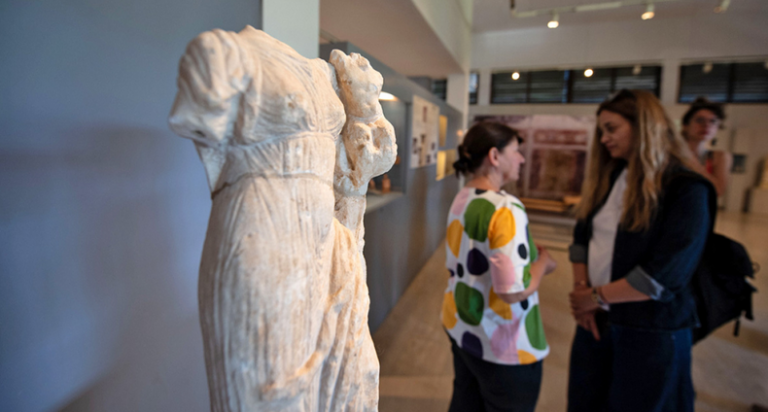As soon as we arrive at Amphipolis, near the current community of Nea Mesolakkia Serres, among the trees and the fields full of flowers, we feel the energy that the place wanted as the prominent center of antiquity, from prehistoric times until the founding of the homonymous city by the Athenians at the time of Pericles but also during the Hellenistic and Roman years.
With the findings constantly being enriched by the recent excavations in Amphipolis and with the latest announcements by the governor of Central Macedonia Apostolos Tzitzikostas and the minister of culture Linas Mendoni that the Kasta Tomb will be visitable in 2027, the area of immense archaeological importance, according to the testimonies of of Herodotus and Thucydides, confirms its impressive beauty up close. In front of us stretches a huge area where, apart from the ancient city, at the mouth of the river Strymonas, the extremely important Acropolis, the cemetery that was outside the walls such as the extremely impressive Kasta Tomb, the various sanctuaries such as that of Kleios and also the rich houses that make a part of Amphipolis literally look like Pompeii!
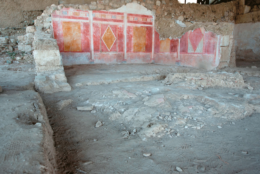
Ancient myths want the vast area stretching from Amphipolis to Philippi, virtually joining East and West, as the place adored by the gods and claimed by various conquerors and leading figures in history. According to one of these myths, Zeus, who turned into golden rain and impregnated Danae, filled the foothills of Pangaeus everywhere with gold! It is about the veins of gold that decorated the green hills like elaborate copper engravings, where the Athenians and the Spartans fought famous battles claiming the natural wealth of Amphipolis. After all, it was from these mines that Philip later minted the coins that made him powerful, as well as his son Alexander.
At the foot of mount Pangaeus, together with the deities that protected it, apart from the mines, stood out the fertile lands and the inestimable wealth of the river that made the area a pole of attraction for all kinds of conquerors, from the Persians to the Athenians and the Spartans, the who arrived at the places with the famous Brasidas as their general as liberators. It is no coincidence that the Athenians conquered the city in 432 BC, at the time of their absolute dominance in all fields, knowing that here they would find a source of endless wealth: from the forests they supplied the wood with which they built the ships, from the gold and silver mines and raw materials such as wheat from the particularly fertile soil. Amphipolis was not only the sacred area but also the place that every leader and emperor wanted for himself.
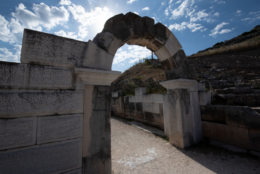
Each small neighborhood of these places was, however, deified in different ways and a walk is enough to understand its importance: you still see the mines in the mountains, you still taste, just like in ancient times, the finest, perhaps, wine of Greece, with wineries constantly multiplying – our passage through Biblia Chora, with the wine of Ovilos considered one of the seven best in the world, confirms the truth of the statement. The vineyards and the granary opposite show why Dionysus, that frenzied protector of wine with his corn and his maenads, had not set up his stronghold here by chance.
It is moving to cross the main road that connects the modern Macedonian cities and see the characteristic signs that say “Egnatia Odos” which, in its ancient version, connected all these areas, from Amphipolis to Thessaloniki until Constantinople where the capital of the Roman Empire was transferred. In the center of this magical place, as a point of reference and as a permanent compass, Mount Pangaeo stands out: at the eastern end of the mountain were the Krinides, which would later be renamed Philippi, and to the west the Nine Streets, which the Athenians would call Amphipolis. Even today with the excavations constantly bringing to light treasures you feel that a certain miracle is taking place here.
You stand, for example, in the middle of the Acropolis in Amphipolis and observe on the one hand the imposing Tomb of Casta, with the new canopy hiding and protecting the priceless treasures inside the tomb, and on the other the vast wealth of nature. A little further, as far as the eye can see, the beautiful Hellenistic house can be seen, while on the other side, the museum set up by Dimitris Bakirtzis stands out with the so-called tomb of Brasidas located at the back – and the treasures, such as the golden olive wreath with the silver urn, where the bones believed to belong to the famous Spartan general were found, adorns the entrance to the museum. Already Thucydides, who fought in the area and was then exiled here as a loser, had already provided the necessary information on the location of the tomb of Brasidas, which strengthened the archaeological theories for the identification of the tomb with the famous Spartan.
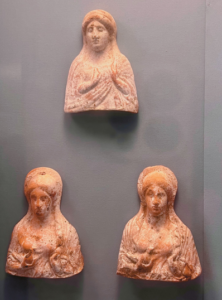
The women of Amphipolis
Other female figures have recently come to light from the adjacent excavations, such as those that fill the display cases of the old museum – until the new one is built – which, together with the built-in statues of the wailing Sirens, the different versions of Artemis in a series from beautiful statues and of course the countless Venuses, show that Amphipolis was, apart from the affairs of leading figures and emperors, (also) a women’s affair. We are impressed not only by the imposing Sphinx, found in the famous tomb at Kasta, but also by the truly beautiful busts of various types of women found during recent excavations and remarkably preserved to this day: the details of the fabrics stand out in red, the necklaces in the neck, the flowers they hold in their hand – that characteristic expression of sadness on the face which reveals that these are busts that accompanied the dead to the tombs.
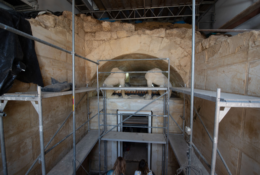
In all of this we were lucky enough to be guided on the trip organized by the Development Societies of Kavala, Drama and Serres with the aim of highlighting the archaeological and historical wealth of the area and to be guided by the super active head of the Antiquities Ephorate of Serres, Dr. Dimitria Malamidou, who knows Amphipolis like few others and shows real love for everything that made this ancient, Hellenistic and Roman city so great. After taking us on a tour of the different parts of the archaeological site, as Amphipolis is not only the Kasta Tomb, she analyzed the different periods that turned the area into a living palimpsest full of sanctuaries, dedicated to domestic and foreign deities, impressive houses and an octagonal Acropolis building and the wall that surrounds it, which justifies why the early Christian basilicas with their impressive mosaics were built here.
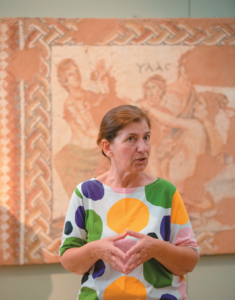
Who is buried
As for the tomb, “we are not sure about its occupant, but we speculate that it is someone prominent, who was related to the royal family,” he points out. He could possibly be an official or associate of Alexander the Great who had stayed in the area, which, moreover, the existing testimonies confirm. Although the original theory of the archaeologist Katerina Peristeris that the tomb belonged to Alexander the Great himself was gradually abandoned, some insist that it is possible that it is a general, with Mrs. Malamidou arguing that the evidence we have so far does not prove any theory. The curator guides us inside the famous Kasta Tomb, where various surprises await us.
As soon as you enter you understand that this is a monument of enormous importance that justifies its reputation: marble Sphinxes guard the interior which is divided into three parts, something not usual for such a monument. Incredible are not only the mosaics with pieces of marble and red mortar that adorn the interior and are found in wider Macedonia, but also the ceiling, the floor and the cladding with Thassos marble. The impressive mosaic of the Rapture of Persephone by Pluto with the psycho-transporter Mercury, which has been moved there for protection, reveals the importance of the monument and directly refers to the other famous mosaic, the Tomb of Persephone, in the palace of Aigea.
Türkiye cancels the decree for the sale of the Elgin marbles
To the right and left are the Caryatids, while in the last chamber of the tomb, which is also the burial chamber, different bones were found that apparently belong to the same family in burials that took place in later phases. As Mrs. Malamidou tells us, a total of bones corresponding to five skeletons were found. It goes without saying that all the elements – Caryatids, Rape of Persephone, Sphinxes – indicate that this is the realm of the Underworld. Restoration work continues inside the monument, while as announced by the Minister of Culture, the entire perimeter of the mound will be restored and everyone is anxiously awaiting the creation of the new museum, which, as the Head of the Ephoria told us, has already provided for through NSRF.
The Hellenistic House
The media frenzy may have focused attention on the mound and the tomb that was found almost a decade ago, but Amphipolis is much more than that: it is the impressive monuments that dominate the heart and surrounds of this magnificent city as well as the priceless treasures that adorn the museum’s showcases: revealing was the well-preserved Hellenistic house, which managed to be protected over the years thanks to the roof, which fortunately came in on time, as Mrs. Malamidou pointed out to us, and shows the wealth of the area. It is a two-story house, with the two rooms on the lower floor standing out even today and referring not only to the Hellenistic houses of Delos, but also to those of Pompeii with their highly impressive frescoes.
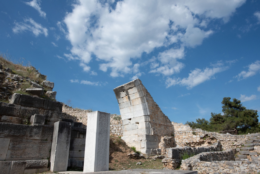
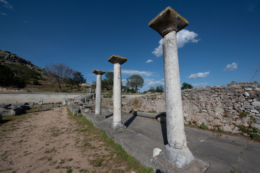
In fact, the specific designs and this red color “give this three-dimensional rendering to the colored bricks”, as Mrs. Malamidou tells us. According to this claim, the house predates similar houses in Pompeii, such as the Samnite House which was the first to witness this style of three-dimensional illusion. It is precisely this that makes the difference and constitutes the revolution of this particular art in relation to the earlier Roman one and for the first time we do not meet it in Pompeii, as is widely believed, but here in this rich house in Amphipolis.
In Philippi
Our trip to the archaeological sites of the Eastern side of Macedonia held many surprises, such as the passage through the highly impressive Alistratis Cave, one of the most beautiful in Europe, in Serres, to finally arrive, crossing all the important centers, in the shadow of Pangaeus , in the iconic Philippi. It is a UNESCO World Cultural Heritage monument of enormous archaeological interest that reveals not only the transition from antiquity to the early Christian world, but also from paganism to Christianity. Crucial for the region, as it turned out, was the Battle of Philippi, between Cassius Brutus and Mark Antony-Octavian, which was ultimately to advance the west of Roman territory in the region. The city founded in 360 BC. it owes its name to Philip II who occupied it a few years later, giving it its characteristic glamour.
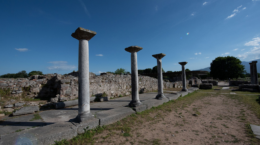
The ancient theater seems it had been used as an arena for gladiators, with the inscriptions standing out, even bearing their characteristic names. The theater introduces you in the most ideal way to the evocativeness of the vast space of Philippi, which connects different eras and religions, and is located at the entrance and next to the administrative center of Philippi and the central market (a statue of Tyche shows the boundaries of ancient Egnatia street). Stand out is the imposing basilica of the Apostle Paul created near an underground Macedonian tomb and a hero that seems to be dedicated to some Kaverian mystery – another proof that different religions were worshiped here and different mysteries took place. It is said that Mithraism, which had arrived here through the Romans, paved the way for Christianity and its worship: it is no coincidence that this area was chosen by the Apostle Paul to teach the new religion and to baptize the first Christian woman, St. Lydia of Philippi. Together with Philip, they are after all the two persons who give the region its lasting glory.
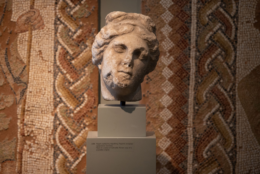
The head of the Ephorate of Antiquities of Kavala, Stavroula Dadaki, took us on a tour of the site of the Philippi, who informed us about the latest works that have been carried out and have brought the site to light, but also about the course of the excavations which continue to bring to light valuable treasures. The relatively recent discovery of a statue head from the 2nd or early 3rd AD is typical, as it seems to belong to a statue of the god Apollo (and because of its incomparable beauty), while on the marble-paved road of Ancient Egnatia coins of the emperor Leo VI were found, which help to accurately determine the duration of the use of the road.
Ask me anything
Explore related questions
